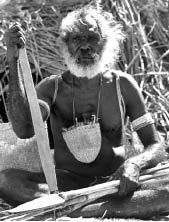Ten Canoes
by Girish Shambu

Our modern lives are submerged, day and night, in an ocean of fictions. Television, movies, books—they’ve poured thousands of stories into our eyes and ears. How many of these stories have we forgotten? Probably many more than we can remember. But imagine a place and time far in the past when stories were rare and the simple act of telling one had the power to change a human life.
The admirable Australian film Ten Canoes is set during such a time. In an Aboriginal tribe, a young man confesses a taboo impulse: He desires his older brother’s wife. When the brother hears of this, he sits the young man down and tells him a mythic folk tale. He hopes that the story will serve as a warning for his sibling. This legend-like parable forms the crux of the film.
Ten Canoes, which won a special jury prize at the Cannes film festival last year, has an interesting backstory. It’s the first major Australian movie shot completely in an Aboriginal language. The directors, Rolf de Heer and Peter Djigirr, filmed it in the remote swamplands of the Australian bush and used non-actors from the Yolngu tribe. Since the filmmakers and actors didn’t share a common language, communication proved very difficult. Even the very concept of “acting”—pretending to be someone fictional—was utterly strange to members of this tribe.
This feeling of strangeness works both ways. There is much in this film that is both breathtaking and unfamiliar to us: lush landscapes of the bush, ancient tribal rituals, Stone Age oral culture, sorcery. And yet it’s all underpinned by certain universal truths about the importance of family, responsibility and (most of all) storytelling.
|
Issue Navigation> Issue Index > v6n33: If You See a Gringo with a Camera, Shoot Him (8/16/07) > Film Clips > Ten Canoes This Week's Issue • Artvoice Daily • Artvoice TV • Events Calendar • Classifieds |









 Current Issue
Current Issue